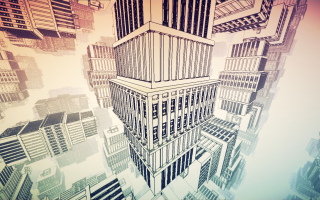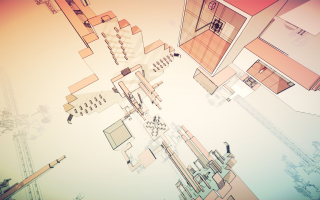Manifold Garden Review 19.99
Leave your logic at the door
In my opinion, one of the most gratifying feelings that can come out of playing a game is that “a-hah!” moment of solving a complex puzzle. The catharsis of finding your way to the solution, and being able to put together the creator’s final vision are both worthy of being dubbed top tier experiences. However, it can be tough to strike that “just right” balance with puzzles. One which you can deconstruct and intuit too quickly makes the moment-to-moment execution feel like busy-work. Equally, having the solution be too obtuse makes it frustrating. The best puzzles are those which encourage experimentation, establish and abide by their own internal logic, and creative in a way to make you want to shake hands with the person (or people) who created them.
 Also in my opinion, some of the most fascinating puzzles are the ones which require lateral thinking – ones which require you to look at individual elements from angles you maybe wouldn’t have initially considered, or which challenge your preconceived expectations going in. Portal is probably the most popular example of this, as was emphasized by its “now you’re thinking with portals” tagline. Another personal favourite of mine has also been Antichamber, which delves into the world of non-euclidean geometry, and subverts your expectations with masterfully crafted, mind-bending puzzles. All of this preamble finally brings us to Manifold Garden, a game by William Chyr Studio.
Also in my opinion, some of the most fascinating puzzles are the ones which require lateral thinking – ones which require you to look at individual elements from angles you maybe wouldn’t have initially considered, or which challenge your preconceived expectations going in. Portal is probably the most popular example of this, as was emphasized by its “now you’re thinking with portals” tagline. Another personal favourite of mine has also been Antichamber, which delves into the world of non-euclidean geometry, and subverts your expectations with masterfully crafted, mind-bending puzzles. All of this preamble finally brings us to Manifold Garden, a game by William Chyr Studio.
Manifold Garden wasn’t really on my radar until it came out. When folks started referring to it as a spiritual successor to Antichamber, I knew I had to go into it as soon as possible, as blind as possible. I absolutely recommend this approach, and if you choose to do so, let me tell you this so you can leave now and feel okay: it is ambitious, well-executed, and a densely packed puzzle experience let down by some performance issues and occasional flaws with control and design. Now go and play it! For those less concerned about being “spoiled,” let’s dive a bit deeper.
 What once was up…
What once was up…
Once in the game, one of the first things you’ll notice is the instantly striking aesthetic. It is cut from the same cloth as both Antichamber and Portal in how it uses a minimalist art style and simple environment to great effect. Upfront, everything is made up of simple shapes, and few colours; but it is what happens the first time you step “outside” which will leave take your breath away. The first thing you’ll see out there is a giant tower. No, not just one, seemingly infinite giant towers. This is coupled with your first challenge – your path to the closest tower is impeded by a large gap you need to cross; but you cannot jump. How can you possibly cross it?
Manifold Garden does not abide by the rules we adhere to in our world. It is non-euclidean and Escher-esque, which means you can’t approach solutions by using silly things like “logic” and “reason.” Upon realizing that all of the towers surrounding you are exactly the same, the solution is to let go of logic and jump into the void. Rather than being met by a kill screen, you continually fall further down, entering an infinitely recursive loop. All of the towers are actually one tower, what you perceive as “up” can change in an instant, and the world is both massive and small all at once. Once your mind has recognized that this is how the world works, the real joy in Manifold Garden is seeing just how creative things will be around the next corner.

The puzzles are consistently creative, and will stretch your mind in satisfying, rewarding ways. I never felt the compulsion to look up a solution because the mere act of discovery itself was so gratifying. By the end, the whole experience took me under 4 hours; but it is so densely packed that I needed to take multiple breaks across those hours. No element or puzzle style ever felt like it overstayed its welcome because the whole package felt cohesive and carefully considered.
While solving the puzzles themselves is often enough of a reward to want to keep going, the game continually dazzles you with visual feasts when you complete each discrete area. These moments are both stunning and mesmerizing in equal parts – especially so as you reach the final moments of the game. These spectacles were so ambitious and creative that the programmer in me kept asking “how did they even do that?” while the game-playing-audience-member in me simply reply “shut up and enjoy it, this is awesome.”
Sometimes is down…
All of that being said, there were flaws which were hard to ignore. For one, performance on my MacBook Pro could occasionally only be classified as “abysmal.” Despite having a dedicated GPU, I had to turn the settings down almost as far as they would go just to have a consistent framerate. I encountered a handful of crashes, and overall was sad to have what was an otherwise fluid and engrossing experience let down by single-digit framerates and crashes to desktop.
 On top of that, occasionally control itself was an issue. There are points where you need to carry objects with you, and I encountered many situations where the object would get stuck on something and I’d need to go back to the start of the whole puzzle in order to continue. Or I’d be going up some stairs and suddenly start falling through the world because I didn’t realize the floor beneath my feet was perforated with large gaps. While this might be a nitpicky, it happened with enough frequency to be a bit frustrating.
On top of that, occasionally control itself was an issue. There are points where you need to carry objects with you, and I encountered many situations where the object would get stuck on something and I’d need to go back to the start of the whole puzzle in order to continue. Or I’d be going up some stairs and suddenly start falling through the world because I didn’t realize the floor beneath my feet was perforated with large gaps. While this might be a nitpicky, it happened with enough frequency to be a bit frustrating.
Lastly, while I absolutely appreciate how little the game holds your hand, it is also entirely possible to get yourself into a situation where the puzzle is unsolvable without even knowing it. Not realizing you had to bring something from a previous area with you into a new one is very easy to encounter, which can result in many confused minutes of exploring every inch of a space without realizing there was a puzzle piece missing the entire time. While I wouldn’t advocate for the game to push for hand holding, I definitely would have appreciated feedback knowing that I was missing a vital piece of the puzzle.
At its worst, Manifold Garden is great. At its best, it is transcendent. It is easily one of the best puzzle games of the past few years, and I can’t even imagine how much effort must have gone into designing the majority of its unique, multi-layered areas. While its flaws definitely detract from the overall experience, it is still a game which is absolutely worth experiencing. It will challenge you, leave you saying “wow” aloud, and consistently surprise you.
Pros
- Uniquely satisfying puzzles
- A world which you want to poke and prod
- Beautiful aesthetics
- Doesn’t overstay its welcome
Cons
- Major performance issues
- Lack of feedback can mean getting stuck at a dead end without knowing.
- Some control & design issues.
